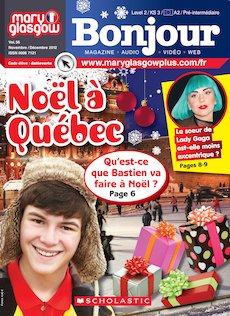Some time ago I wrote a post about the Mary Glasgow website and how I used its free Spanish articles and audio versions. Last week I received several French sample magazines and the “Bonjour” one aimed at pre-intermediate learners caught my eye. The cover page is about Christmas in Québec. Since we are getting ready for Christmas here in Germany with the Advent markets going on in every towns and cities, I thought this would be a great reading activity for my little French student. The article is an interview with Bastien, a 14 years old boy who lives in Québec and explains what he is going to do during Christmas. The focus is on the near future tense and although my student is not so advanced (she can only use the present tense so far), I thought I could give it a try.
What I like about Mary Glasgow magazines is that they always come with a little booklet for teachers with different examples of lesson plans for each article in the magazine. Each lesson plan is detailed with objectives and then with different activities either focusing on speaking or on reading and writing skills. In the case of the article about Christmas in Québec, here are some activities I could do with my student:
- draw a list of all the French words related to Christmas or a celebration she already knows.
Then, look at the pictures on the article and describe them using the words from the list. - introduce the near future tense: aller + a verb in the infinitive form and then read the article and highlight all the sentences with the near future tense.
- have a conversation asking questions about Christmas plans. To make it easier and also to use the near future tense, my questions would follow this pattern: Bastien is going to decorate his house. Are you going to decorate your house? = Bastien va décorer sa maison? Toi, tu vas décorer ta maison?
The other great bonus is that the magazines and booklets come with a code to access videos, activities and resources on the website. Thanks to Mary Glasgow’s ideas and articles, teachers are able to plan engaging lessons linked to the francophone culture as well as to key structures. Learners can also benefit a lot from reading the magazines. I subscribed to the Spanish ones and whenever I want to help a student on a one to one basis, I ask the other students to read one of the magazines according to their levels. I can see they really enjoy reading the articles because they relate to their interest. They also like completing the little quizzes at the end of the articles. The answers come at the end of the magazine so they can check their comprehension skills on their own. It helps develop their independence and confidence. Some students have said to me: “Wow, I can read a magazine in Spanish!”.
What about you? Do you use Mary Glasgow? How?
